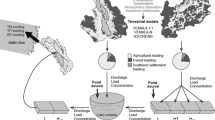Abstract
The phosphorus concentrations exported from wetlands are explored via data and a first order model. The graph of outlet concentration versus areal phosphorus loading is used to display these data and the model. For a given wetland, data and models show that P concentrations show an ‘S’ curve response to increasing P loadings. The lower plateau is the background concentration and the upper plateau is the inlet concentration. The position of the ascending limb between the two plateaus is positioned differently for different wetlands. Phosphorus (P) removal in wetlands is often typified by a stable decreasing gradient of P concentrations from inlet to outlet, and an accompanying stable decreasing gradient in P assimilation. Limits to removal are inherent in the physical, chemical and biological processes. A lower outlet concentration limit exists because of the P cycle in the un-impacted wetland. The loading at which the outlet concentration departs from background, the lower knee in the loading curve, varies from wetland to wetland. An upper outlet concentration limit is imposed by the source concentration for extremely high inflows. The first order mass balance equation interpolates between these limits. The model gives further insights about performance within an overall envelope. The water carrying capacity of the wetland precludes flows in excess of the hydraulic conveyance capacity, thus limiting the possible P loadings to the system. Conversely, extremely low hydraulic loadings cause the wetland to be dominated by atmospheric additions and losses. The central tendency of inter-system data in the North American Database is shown to be inadequate to draw generalized conclusions about ecosystem processes in an individual wetland. The proposed ‘one gram rule’ of Richardson, et al. (1997) is shown to be an over-simplification.
Similar content being viewed by others
References
Craft, C.B. and Richardson, C.J. 1993. Peat accretion and phosphorus accumulation along a eutrophication gradient in the northern Everglades. Biogeochem. 22: 133–156.
Davis, S.M. 1981. Mineral Flux in the Boney Marsh, Kissimmee River, Technical Publication 81–1, South Florida Water Management District, West Palm Beach Florida. Hammer, D.E. and Kadlec, R.H. 1980. Ortho-phosphate adsorption on peat. pp. 263–269. Proceedings of the 6th International Peat Congress, Duluth, Minnesota.
Herskowitz, J. 1986. Listowel Artificial Marsh Project Report, Ontario Ministry of the Environment, Water Resources Branch, Toronto.
Kadlec, R.H., 1994. Phosphorus uptake in Florida marshes. Wat. Sci. Technol. 30: 225–234.
Kadlec, R.H., 1997a. An autobiotic wetland phosphorus model. Ecol. Engr. 8: 145–172.
Kadlec, R.H., 1997b. Deterministic and stochastic aspects of constructed wetland performance and design. Wat. Sci. Technol. 35: 149–156.
Kadlec, R.H., 1998. The inadequacy of first order treatment wetland models. Ecol. Engr., submitted.
Kadlec, R.H. and Knight, R.L. 1996. Treatment Wetlands, CRC Press, Boca Raton, FL.
Knight, R.L., Ruble, R.W., Kadlec, R.H. and Reed, S.C. 1993. Wetlands for Wastewater Treatment Performance Database. pp. 35–58, In: Moshiri, G.A. <nt>(ed.)</nt>, Constructed Wetlands for Water Quality Improvement. Lewis Publishers, Boca Raton, FL.
Lowe, E.F. and Keenan, LW. 1997. Managing phosphorus based, cultural eutrophication in wetlands: a conceptual approach. Ecol. Engr. 9: 109–118.
Mierau, R. and Trimble, P. 1988. The Hydrologic Characteristics of the Kissimmee River Floodplain Boney Marsh Experimental Area. September, 1988. Technical Memorandum, South Florida Water management District, West Palm Beach, FL.
Moustafa, M.Z., M.J. Chimney, T.D. Fontaine, G. Shih and Davis, S. 1996. The response of freshwater wetland to long-term 'low level' loads-marsh efficiency. Ecol. Engr. 7: 15–34.
Qian, S., 1995. A Nonparametric Bayesian Model of Phosphorus Retention in Wetlands. Ph.D. Dissertation, Duke University, Nicholas School of the Environment, Durham, NC.
Reckhow, K.H. and Qian, S.S. 1994. Modeling phosphorus trapping in wetlands using generalized additive models.Wat. Resour. Res. 30: 3105–3114.
Reddy, K.R., DeBusk, W.F., Wang, Y., DeLaune, R. and Koch, M. 1991. Physico-Chemical Properties of Soils in the Water Conservation Area 2 of the Everglades, Report to the South Florida Water Management District, West Palm Beach Florida.
Reddy, K.R., O. A. Diaz, L.J. Scinto, and Agami, M. 1995. Phosphorus dynamics in selected wetlands and streams of the Lake Okeechobee basin. Ecol. Engr. 5: 183–208.
Reddy, K.R., R.H. Kadlec, P.M. Gale and Flaig, E. 1998. Phosphorus assimilation in streams and wetlands. Critical Reviews in Environmental Control, in press.
Richardson, C.J. and Vaithiyanathan, P. 1995. Phosphorus sorption characteristics of Everglades soils along a eutrophication gradient. Soil Sci. Soc. Am. J. 59: 1782–1788.
Richardson, C.J., Craft, C.B., Qualls, R.G., Rader, R.B. and Johnson, R.R. 1992. Effects of Nutrient Loadings and Hydroperiod Alterations on Control of Cattail Expansion, Community Structure and Nutrient Retention in the Water Conservation Areas of South Florida, Publication 92–11, Duke Wetland Center, Duke University, Durham, NC. Richardson, C.J., Qian, S.S., Craft, C.B. and Qualls, R.G. 1997. Predictive models for phosphorus retention in wetlands. Wetlands Ecol. Mangmt. 4: 159–175.
Rosendahl, P.C. 1981. The determination of Manning's roughness and longitudinal dispersion coefficients in the Everglades marsh. 22 pp. Paper presented at the Symposium on Progress in Wetlands Utilization and Management, Orlando, FL, June 1981.
SFWMD (South Florida Water Management District) 1998. Water Quality Conditions Report, April, 1998. Water Resources Evaluation Department, South Florida Water Management District, West Palm Beach, FL.
Walker, W.W. 1995. Design basis for Everglades stormwater treatment areas. Wat. Resour. Res. Bull. 31: 671–685.
Author information
Authors and Affiliations
Rights and permissions
About this article
Cite this article
Kadlec, R. The limits of phosphorus removal in wetlands. Wetlands Ecology and Management 7, 165–175 (1999). https://doi.org/10.1023/A:1008415401082
Issue Date:
DOI: https://doi.org/10.1023/A:1008415401082




